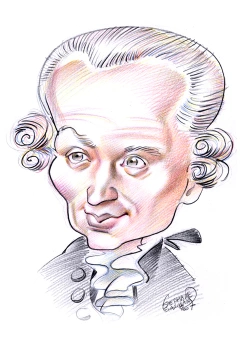THE TRANSCENDENTAL AESTHETIC -KANT
Publié le 09/01/2010
Extrait du document

Like his seventeenth- and eighteenth-century predecessors, Kant thinks of a sense-faculty as being in itself a passive power of receiving representations. However, he makes a distinction between the matter and the form of our experience: the matter is what derives directly from sensation, the form given by our understanding is what permits the chaos of appearance to take on order. The matter of sensations would include what makes the difference between a glimpse of blue and a glimpse of green, or the smell of a rose and the smell of a cheese. But what Kant is interested in is only the form. In human experience any object of sense is also an object of thought: whatever is experienced is classified and codified, that is to say, it is brought by the understanding under one or more concepts. Kant wants to isolate sense-experience by taking away from it everything which really belongs to the understanding, so that nothing may be left save immediate empirical experience and its a priori form. ‘In the course of this investigation,' Kant says, ‘it will be found that there are two pure forms of sensory awareness, serving as principles of a priori knowledge, namely, space and time.' Like his predecessors Kant accepts a distinction between inner and outer senses. Space is the form of outer sense, by which we ‘represent to ourselves objects as outside us, and all without exception in space'. Time is the form of inner sense by means of which the mind experiences its own inner states, all ordered in time.
Liens utiles
- THE TRANSCENDENTAL DIALECTIC: THE CRITIQUE OF NATURAL THEOLOGY - KANT
- Encyclopedia of Philosophy: THE TRANSCENDENTAL DIALECTIC: THE ANTINOMIES OF PURE REASON - KANT
- THE TRANSCENDENTAL DIALECTIC: THE PARALOGISMS OF PURE REASON - KANT
- THE TRANSCENDENTAL ANALYTIC: THE SYSTEM OF PRINCIPLES - KANT
- THE TRANSCENDENTAL ANALYTIC: THE DEDUCTION OF THE CATEGORIES -KANT































